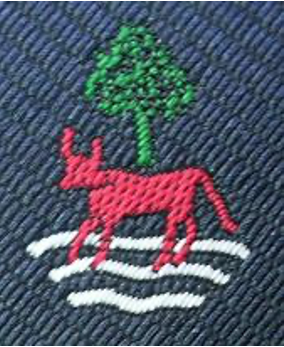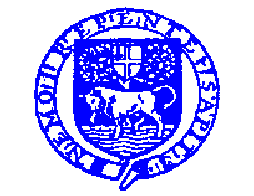The following text is taken from a School magazine where popular teacher Ian (Spud) Taylor explained the origins of the School Crest and Mottoes. Some text and several images are missing – which lacunae we hope to repair soon:
“Oxford High School was from its foundation the City School. The Corporation gave the land and the sum of f4,000: the rest of the cost of §10,000 for the original building (the hall, the four rooms beneath, and the two staircases) was borne by the University, various Colleges, and numerous well-wishers both within and without the University.
It is interesting to note that the foundation of the School, after years of frustration, was probably the first enterprise in which members of town and gown, ever jealous of each other’s privileges, co-operated whole-heartedly. The leading figure was Professor T. H. Green but the Town Clerk, Robert Hawkins, is believed to have taken an active though less obvious part in the venture. Very appropriately then, the panels on the flanks of the staircase window were inscribed with the motto Dominus illuminatio mea of the University and the ancient Fortis est veritas of the City, the latter now entirely smothered by the Ampelopsis creeper. The School, as we were reminded at a recent prize-giving, was thus a unique school, founded in a unique city, as the result of a unique effort seventy years ago. Incredible as it may now seem, there was no school for Oxford boys able to prepare them for the University at their very doors. How much local boys of that time appreciated the opportunity for study can be assessed by the School’s remarkable record of open scholarships and exhibitions, and later, of fellowships and public honours, which were achieved by her sons. Some of the early history is dealt with by Sir Arthur Salter in the first two numbers of the School Magacine (1903).
The shield of arms worn as a badge on blazer and cap for the past twenty-five years was taken from the device carved by Sir T. G. Jackson on the front of the building and on the pediments above the doors in the hall. The motto Nemo repente sapit appears on one of the panels of the front door. There was never any formal grant of arms, but these have become by use the accepted arms and motto of the School.

The familiar shield of the City of Oxford bears on a silver field a red ox crossing a ford represented by six wavy bars of blue and silver. The shield of the School bears, in addition, a tree in the background and a small shield of the City of London in one corner. These arms, without doubt, are based on the design which graced the note-paper of the Town Clerk, Mr. Hawkins, at the time the School was built (1880), but the charges there are pictorial and set within a circle rather than a shield.
The origin of this device lies in the medieval seals described below. Henry II, during the chancellorship of Thomas Beckett (1154-1162), gave Oxford by royal charter comparative freedom from official interference. Among other things, the trade guilds and citizens were to share the same rights and customs as the citizens of London, including the right of representatives to serve in the buttery at the coronation feast. These privileges were confirmed and extended by the more important charter of 1199 granted by Richard Coeur de Lion in consideration of the townspeoples’ cheerful payments to secure his release from his German prison. No doubt this charter involved further expenditure, but was timely since the citizens of London had monopolised the buttery at the Lionheart’s second coronation at Winchester on his return to England.
The Common Seal of all the Citizens of the City of Oxford, inscribed STGTII.(VM) COMMUNE OMNIVS CIVIV(M) CIVITATIS OXENEFORDI(A)E, a symbol of the incorporation, was made in 1199 or very shortly after, and is illustrated here. It shows the ox, punning on the name of the place, within the embattled walls of a medieval town, a symbolic triple-towered castle in the back-ground. It remained in constant use till 1574, when the Tudor heralds accompanying Queen Elizabeth to Oxford on her second visit granted, to a shield bearing an ox and ford, the addition of a crest and supporters. This has only been modified since by the unimportant embellishments of 1634, to this day omitted from the Common Seal.
The Rev. H. E. Salter in the Ford Lectures, Medieval Oxford (Oxf. Mist, Soc., 1986), discusses the origin of the office of mayor, which would appear to date from about 1205. Other boroughs, too, about this time were clamouring for permission to elect a mayor (from the French maire, Latinised marrus, but soon corrected to maior), for it was popularly believed that such an officer would bring a millennium in local government. As responsible persons, mayors were often called upon to witness deeds: when few men could write even their own names, the custom was to apply a seal. Each man of any standing provided his own simple design, corporations and nobility having more elaborate ones.
The carliest mayoral seal, here illustrated (from MS. Ch. Ch. Deeds, Oseney Charters 594, dated 1323, in the Bodleian Library) bears an ox facing the sinister, a ‘tree ‘ above, and an inscription in Lombardic lettering. SIGILUM MAIORATVS OXON(IAE), i.e. the Seal of the Mayoralty of Oxford. The style is that of the end of the thirteenth century or the beginning of the fourteenth. The carliest use of it on any document in the Bodleian is 1316. This first seal remained in use for about a century when it was replaced. [Dr. Salter refers to a similar specimen of 1373, illustrated in Oriel College Records (O.H.S.), as the second seal, but on enquiry he informs me that it should have been called the first.] There is every reason to expect the tree, or slip of leaves, to have a meaning, to be a rebus on the office or its holder. No pun is apparent from the names of the early mayors unless, as my friend Mr. E. A. Greening Lamborn hazards, the tree suggests William of Burcestre (Bicester), who was eleven times mayor between 1311 and 1339. [Section missing] editor of Tudor civic records, introduced the sword in order to suggest the association of the two ancient municipalities and their common rights, though the change may have been accidental.
It is thus from the modified version of the 550-vear-old seal that the School arms descend. It is very unlikely, however, that any change will now be made in the use of a coat of arms which was set in stone almost seventy years ago.
The ‘new School Crest (sic)’ in the Magazine for December 1927 introduces the effective design of the late Mr. George Kruger Gray, whose initials, K.G., may also be seen on the backs of our silver coinage. It was a great improvement on the anaemic pattern in use since 1923, but took liberties with the colour of the field. For the first time the motto was incorporated on a ribbon. For the present account, Mr. B. A. Field has kindly redrawn the School arms, paying particular attention to natural and heraldic details.
On the subject of the School motto, Nemo repente sapit, i.e. No one becomes wise of a sudden, there is little to be written, though the truth is very profound. Its origin is obscure, but it appears to be derived from ‘Nemo repente fuit turpissimus’ of Juvenal (Satires, ii, S3). Perhaps Professor Green himself was responsible for this as for many other details of the School he cherished. The other epigram carved on the front door, Labor vincit omnia, also a profound truth, is perhaps too much overworked to serve for a motto. Subject to future research by members of the Classical Sixth, I provisionally assign it as a hybrid between ‘Labor omnia vicit improbus’ (Virgil: Georgics, i, 145-6) and ‘Omnia vincit Amor et nos cedamus Amori’ (Virgil: Ecologues, x, 69-70).”
I. H.T.
